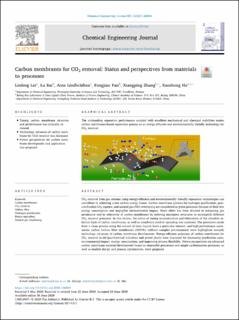Carbon Membranes for CO2 Removal: Status and Perspectives from Materials to Processes
Peer reviewed, Journal article
Published version

Åpne
Permanent lenke
https://hdl.handle.net/11250/2677570Utgivelsesdato
2020Metadata
Vis full innførselSamlinger
Sammendrag
CO2 removal from gas streams using energy-efficient and environmentally friendly separation technologies can contribute to achieving a low-carbon energy future. Carbon membrane systems for hydrogen purification, post-combustion CO2 capture, and natural gas (NG) sweetening are considered as green processes because of their low energy consumption and negligible environmental impact. Much effort has been devoted to enhancing gas permeance and/or selectivity of carbon membranes by tailoring micropore structures to accomplish different CO2 removal processes. In this review, the status of tuning microstructure and fabrication of the ultrathin selective layer of carbon membranes, as well as membrane module upscaling was analyzed. The precursors made from a clean process using the solvent of ionic liquids have a particular interest, and high-performance asymmetric carbon hollow fiber membranes (CHFMs) without complex pre-treatment were highlighted towards technology advances of carbon membrane development. Energy-efficient processes of carbon membranes for CO2 removal in oil/gas/chemical industries and power plants were discussed for decreasing production costs, environmental impact, energy consumption, and improving process flexibility. Future perspectives on advanced carbon membrane material development based on renewable precursors and simple carbonization processes, as well as module design and process optimization, were proposed.